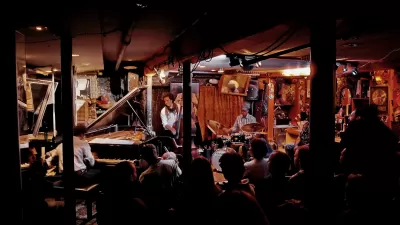A group of venue owners formed in response to the pandemic successfully got a $15 billion support bill passed to help small venues stay afloat during the pandemic.

Writing for Bloomberg CityLab, Rebecca Greenwald reports on the Save Our Stages Act, an initiative started by music venue owners that could help prop up independent venues during pandemic closures. Signed into law on December 27, the $15-billion piece of legislation is an unprecedented show of support for arts and culture—"for context, the National Endowment for Arts has awarded a total of around $5.5 billion since its founding in 1965."
Originally proposed by a newly formed nationwide coalition of music venues, the National Independent Venue Association (NIVA), the Save Our Stages Act recognizes the challenges faced by live entertainment venues, whose expenses to keep shuttered venues alive are putting many of them out of business. Unlike other businesses, federal programs like the Small Business Administration's Paycheck Protection Program don't necessarily help music venues. "The program’s mandate to put the majority of funds towards payroll rather than rent, mortgage, utilities and other overhead costs was completely untenable for businesses that weren’t open or operational," writes Greenwald, citing the average rent for independent venues as ranging between $10,000 and $60,000 per month.
Championed by Minnesota Senator Amy Klobuchar and co-sponsored by Texas Senator John Cornyn, the Save Our Stages Act focuses on "small business and economic recovery" and marks a "momentous occasion" for the NIVA. The group plans to continue its activism after the pandemic and use their newfound political voice to be "a player in Washington."
FULL STORY: How Music Venues Convinced Congress to Save Live Entertainment

Planetizen Federal Action Tracker
A weekly monitor of how Trump’s orders and actions are impacting planners and planning in America.

San Francisco's School District Spent $105M To Build Affordable Housing for Teachers — And That's Just the Beginning
SFUSD joins a growing list of school districts using their land holdings to address housing affordability challenges faced by their own employees.

The Tiny, Adorable $7,000 Car Turning Japan Onto EVs
The single seat Mibot charges from a regular plug as quickly as an iPad, and is about half the price of an average EV.

Seattle's Plan for Adopting Driverless Cars
Equity, safety, accessibility and affordability are front of mind as the city prepares for robotaxis and other autonomous vehicles.

As Trump Phases Out FEMA, Is It Time to Flee the Floodplains?
With less federal funding available for disaster relief efforts, the need to relocate at-risk communities is more urgent than ever.

With Protected Lanes, 460% More People Commute by Bike
For those needing more ammo, more data proving what we already knew is here.
Urban Design for Planners 1: Software Tools
This six-course series explores essential urban design concepts using open source software and equips planners with the tools they need to participate fully in the urban design process.
Planning for Universal Design
Learn the tools for implementing Universal Design in planning regulations.
Smith Gee Studio
City of Charlotte
City of Camden Redevelopment Agency
City of Astoria
Transportation Research & Education Center (TREC) at Portland State University
US High Speed Rail Association
City of Camden Redevelopment Agency
Municipality of Princeton (NJ)




























